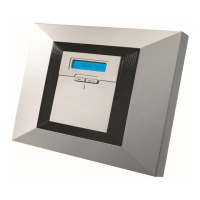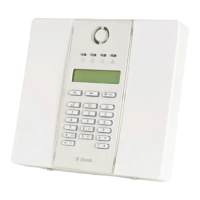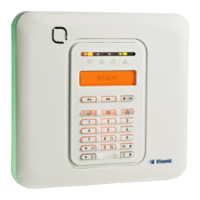DE5467IP 29
D4. Flood Zone
A flood zone is permanently active (a flood alarm is
triggered regardless of whether the system is armed or
disarmed). Upon detection of flood leak, the event is
reported via the telephone line.
D5. Gas Zone
A gas zone is permanently active (a gas alarm is triggered
regardless of whether the system is armed or disarmed).
Upon detection of gas leak, the event is reported via the
telephone line
.
D6. Interior Zone
Interior zones are zones within the protected premises that
have nothing to do with perimeter protection. Their most
important feature is that they allow free movement within
the protected area without initiating an alarm, provided that
the system is armed in the "HOME" mode. People can
therefore stay at home and move about freely, as long as
they do not disturb a PERIMETER zone.
Once the system is armed in the AWAY mode (all zones
are protected), interior zones will initiate an alarm if
violated.
D7. Interior Follower Zones
"Interior Follower" zone is a zone that is located between
entry/exit zone and the alarm system control panel. This
zone is temporarily
ignored by the alarm system during
entry/exit delay periods, to enable you to walk (without
causing an alarm) in front of a motion detector that is
associated with the Interior Follower zone, after you enter
through an entry zone on the way to the control panel, or
when leaving the protected premises after system arming.
D8. Non-Alarm Zones
A non-alarm zone does not directly participate in the alarm
system. Its main use is to perform auxiliary remote control
tasks such as opening/closing a gate,
activating/deactivating courtesy light and similar
applications. No alarm, silent or otherwise, is associated
with a non-alarm zone.
For remote control of electrical devices, you can define the
desired number of non-alarm zones and enroll a portable
transmitter or a wireless device (detector) to this type of
zone. Then, you must ensure that these zones are
permitted to control the PGM output, or the X-10 units or
both (see par. 4.7). Next, you can select the zones (3 at
most) that will control each output. The outputs, in turn, will
control the external electrical devices.
Note: A device control can also be carried out by holders
of all keyfob transmitters, by pressing the AUX [
M
] button.
This method will work provided that you programmed the
[
M
] button for PGM/X-10 control (see Para. 4.4.17), and
that you programmed the PGM output and the X-10 units
to be controlled by keyfob transmitters (see par. 4.7).
D9. Perimeter Zones
Perimeter zones rely on detectors designed to protect
doors, windows and walls. An immediate alarm is initiated
when such a zone is violated by opening the door/window
or by trying to break the wall.
D10. Perimeter Follower Zones
A non-entry/exit zone, typically a perimeter zone located
on an entry/exit path, that is treated as an entry/exit zone
during an entry/exit time.
D11. 24-Hour Zones
24 hour zones are mainly used for PANIC buttons,
perimeter detectors and anti-tamper protection. They
therefore trigger an alarm in both armed and disarmed
states.
• 24 Hour Zone - Silent. - Upon detection, this zone
initiates a silent alarm, meaning that the sirens do not
function. Instead the PowerMax+ dials telephone
numbers and reports the event to central stations and/or
to private telephones, as programmed.
• 24 Hour Zone - Audible. - Upon detection, this zone
initiates a siren alarm. The PowerMax+ also dials
telephone numbers and reports the event to central
stations and/or to private telephones, as programmed.
APPENDIX E. PowerMax+ Compatible Devices
E1. PowerMax+ Compatible Detectors
Each detector compatible with the PowerMax+ system is
packed with its own installation instructions. Read them
carefully and install as indicated.
A. PIR Motion Detectors
The wireless passive infrared (PIR) motion detectors used
in the system are of the PowerCode type. The PowerMax+
is capable of “learning” each detector’s identification code
and linking it to a specific zone (see par. 4.3 in this Guide).
Some units are shown below:
NEXT
®
K9-85 MCW
MCPIR-3000
or K-940 MCW
DISCOVERY
K9-80/MCW
MCPIR-3000 is not UL-listed!
Note: K-940 MCW, Discovery K9-80/MCW and NEXT
®
K9-85 MCW are pet immune units.
In addition to its unique 24-bit identification code, each
detector transmits a message, containing status
information:
• The detector is in alarm (or not).
• The detector is being tampered with (or not).
• The battery voltage is low (or normal).
• “This is a supervisory message”.
If any of these detectors detects motion, it sends out a
message to the alarm control panel. If the system is in the
armed state, an alarm will be triggered.
B. Magnetic Contact Transmitter
MCT-302 is a PowerCode magnetic-
contact transmitter used to detect the
opening of a door or a window.
The alarm
contacts are closed as
long as the door or
window remains
closed.
MCT-302
The unit has an extra alarm input that acts as if it were a
separate wireless transmitter. It sends (or does not send) a
“restored to normal“ message to the alarm system,
depending on the setting of an on-board “DIP” switch. The
“restore” message informs you, through the control panel’s
display, whether the door or window is open or closed.

